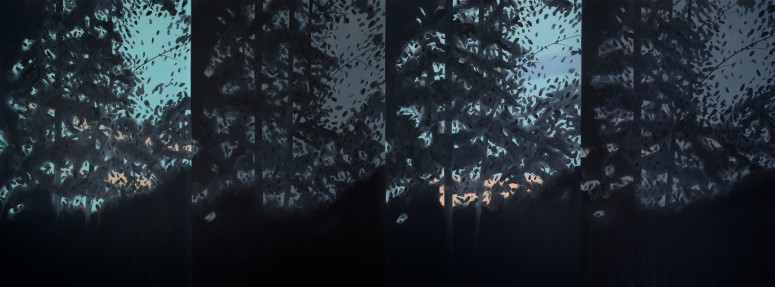
My Mother's Dream
My Mother's Dream (7:45 pm Monday; 7:45 pm Tuesday; 7:45 pm Wednesday; 7:45 pm Thursday), 1998
Oil on linen, 320 x 868.7 cm
Courtesy the artist
© VEGAP, Bilbao, 2015
“In the '90s I went back to large landscapes but I got the idea of making an environmental landscape. Most landscapes are in the distance, so the idea was a wrap-around painting—one that wraps around you so that you’re in the landscape” (1)
INTRODUCTION
Alex Katz (b. 1927) was born to Russian parents in Brooklyn, New York, at the beginning of America’s Great Depression. Due to the economic crisis his family moved to St. Albans, a diverse community in Queens, New York, that had sprung up between the two wars. His mother had been an actress and was passionate about poetry and his father, a businessman, also had an interest in the arts. Katz attended a high school known for its unique program: mornings in academics and afternoons in the arts. In 1946, Katz entered The Cooper Union in Manhattan, a prestigious college of art, architecture, and engineering. His passion for landscape started around that time. Upon graduation, Katz was awarded a scholarship to study at the Skowhegan School of Painting and Sculpture over the summer in rural Maine, where he was exposed for the first time to en plein air, painting outdoors. Katz explains that Skowhegan’s en plein air gave him “a reason to devote [his] life to painting” (2). He found that the simultaneity of light, color, and movement provided an opportunity to paint in an almost unconscious way, producing an image immediately in response to nature (3).
By the late 1980s, his landscapes became larger, which he characterized as “environmental landscapes.” Rather than observing a scene from a distance, the viewer is wrapped by the painting, enveloped by nature. Katz’s goal was to make the viewer feel contained in the landscape, instead of just looking at the painting as an observer.
My Mother's Dream (7:45 pm Monday; 7:45 pm Tuesday; 7:45 pm Wednesday; 7:45 pm Thursday) (1998) is one of Katz’s largest environmental landscape paintings. The work consists of four large panels, each depicting separate moments of the same setting at dusk on different days of the week. The four different, nonconsecutive scenes suggest a jump backward or forward in time, similar to a poem or musical rhythm, where a sequence is established and repeated throughout the composition (4).
With his environmental landscapes Katz’s aim is to pursue “quick things passing,” record the speed of time, and capture the rapidly observed moments and specific conditions of light in the landscape. He describes his ultimate goal as painting in “the present tense,” or the simultaneity of vision and awareness. Katz sees this moment as an explosive “flash” just before an image comes into focus (5).
To fulfill this goal, he strips away information about the appearance of things by removing details to the point of almost transforming subjects into stains of paint. This style allows him to depict his subjects in a way that is as much about the essence of the form as it is about the light, time, and environment.Katz stated that he eliminates unnecessary information about the structure of objects and captures the ineffable passage of time (6).
1. http://uk.phaidon.com/agenda/art/articles/2010/april/24/alex-katz-on-his-works-worries-and-wife/
2. http://www.alexkatz.com/biography/narrative_bio
3. Michael Rooks, It all goes down in your mind. Exhibition catalogue. page 14
4. http://cms.guggenheim-bilbao.eus/src/uploads/2015/08/Dossier-Alex-Katz_EN.pdf
5. Ibid.
6. https://www.high.org/~/media/Sites/HMA/Res/PDF/Press/2014/October/Alex-Katz-Release-FINAL.ashx
Preguntas
Show: My Mother’s Dream (1998): Ask your students to imagine that we could step inside this painting. Where are we? How can you tell? What is the weather like? What can you smell, hear, and feel?
What do you notice about Katz’s use of color, lighting, and shading? How would you describe them?
Describe the mood of this painting. What elements and techniques does Katz use to trigger that response?
My Mother’s Dream (1998) is one of Katz’s largest environmental landscape paintings. With this type of painting, he intends to have the viewer feel like they are inside the landscape, rather than looking at the painting as a distant observer. What elements is he using to accomplish this?
Be sure to mention the size of the painting. (1) How do you think you might respond differently if the painting was much smaller or a different shape?
Ask students to think of a time when they have been in a natural setting. What were the most interesting elements of the landscape? What might be difficult to capture in a painting?
The complete title of the work is My Mother’s Dream (7:45 pm Monday; 7:45 pm Tuesday; 7:45 pm Wednesday; 7:45 pm Thursday). Why do you think Katz added the times to the title? In your opinion, is it possible to capture a moment in a painting? How is it different from photography?
1. To clarify its size, you can point out the dimensions listed in the caption and compare a student’s height or you can show a short time-lapse movie of the installation of My Mother’s Dream online at https://vimeo.com/60789330.
